In the fall of 1916 — the darkest days of the war — British Columbian voters went to the polls in a provincial general election. When the dust settled, the reform-minded Liberals under the leadership of Harlan Brewster came to power, ending thirteen years of Conservative rule in British Columbia. Before the election Conservative Premier William Bowser, who had taken over the leadership from Richard McBride less than a year before, had promised voters two binding referenda to run concurrently with the election on September 14th. The first was a referendum on women’s suffrage. The second was on the prohibition of alcohol. Both of these reform initiatives had overlapping movements with a long history that stretched far back into the nineteenth century, and both were given new strength by the demands of war. On Election Day voters not only rejected the Conservatives, who faced the electorate under a cloud of financial scandal and a sluggish provincial economy not yet invigorated by wartime contracts. They also voted yes on both referendums, effectively endorsing the right of women to vote and run at the provincial level and prohibition within the borders of the province. These two developments represented the most concrete political changes that took place at the provincial level during the war, and James Fitzmaurice documented the politics of women and drink in a series of cartoons in the war’s final year.
The so-called “Purity Election” campaign in the late summer of 1916 was the first sustained political event Fitzmaurice put his pen to after his return to Vancouver in July 1916. The Province newspaper’s Conservative sympathies during the campaign were obvious; the Liberals were criticized as naïve and inexperienced, and Brewster was condemned as unduly negative about the province’s economic future. For his part, Fitz focussed very little on either reform referenda during the campaign, likely because the candidates and parties themselves failed to provide any clear and distinctive positions on either issue. Bowser and the Conservatives had never supported women’s suffrage or prohibition in the past and had brought in the referenda as a cheap political ploy to capture votes from the Liberals. Conversely, the Liberals had painted themselves as the party of reform and therefore had no intention of campaigning against initiatives that had been part of their official party platform since 1912. None of this partisan confusion gave Fitzmaurice a clear position upon which to visually comment.
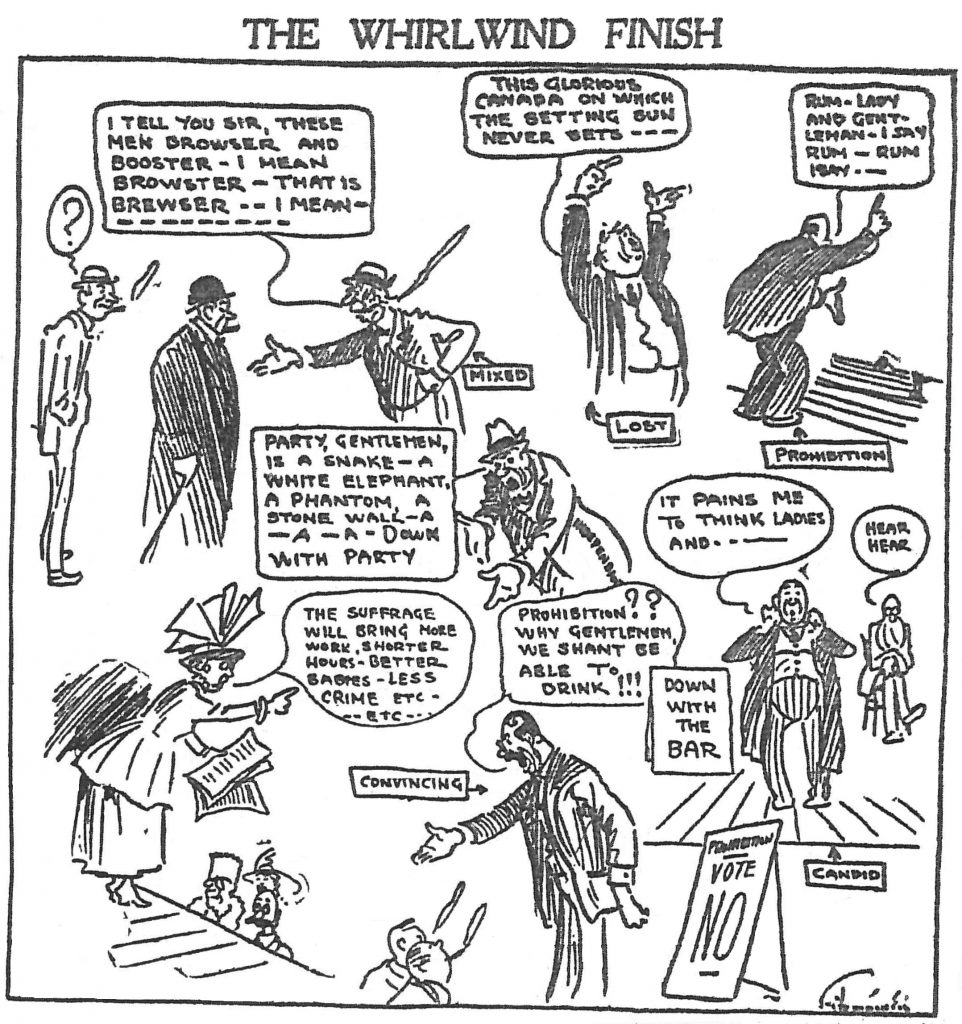
Figure 1: The Whirlwind Finish
The cartoon “The Whirlwind Finish” (Figure 1), which appeared the day before the vote, reflects the muddiness on the two issues. Women’s suffrage, considered a forgone conclusion and facing little organized opposition during the campaign, occupied only a single vignette in the image, while prohibition, a much more contentious issue, was the more prominent theme. To Fitzmaurice, women had gained the right to vote and hold political office – hence the cartoon suffragette in the image informing her audience once again the long and familiar list of social advantages to women’s enfranchisement. Prohibition, however, was a terrible mistake! In Fitz’s eyes, depriving men of their drink was a crime against manhood. Leading up to the election, many of his cartoons featured male characters in disbelief that limits on alcohol consumption might be imposed. Says one here, “Prohibition?? Why gentlemen, we shant be able to drink!!!”
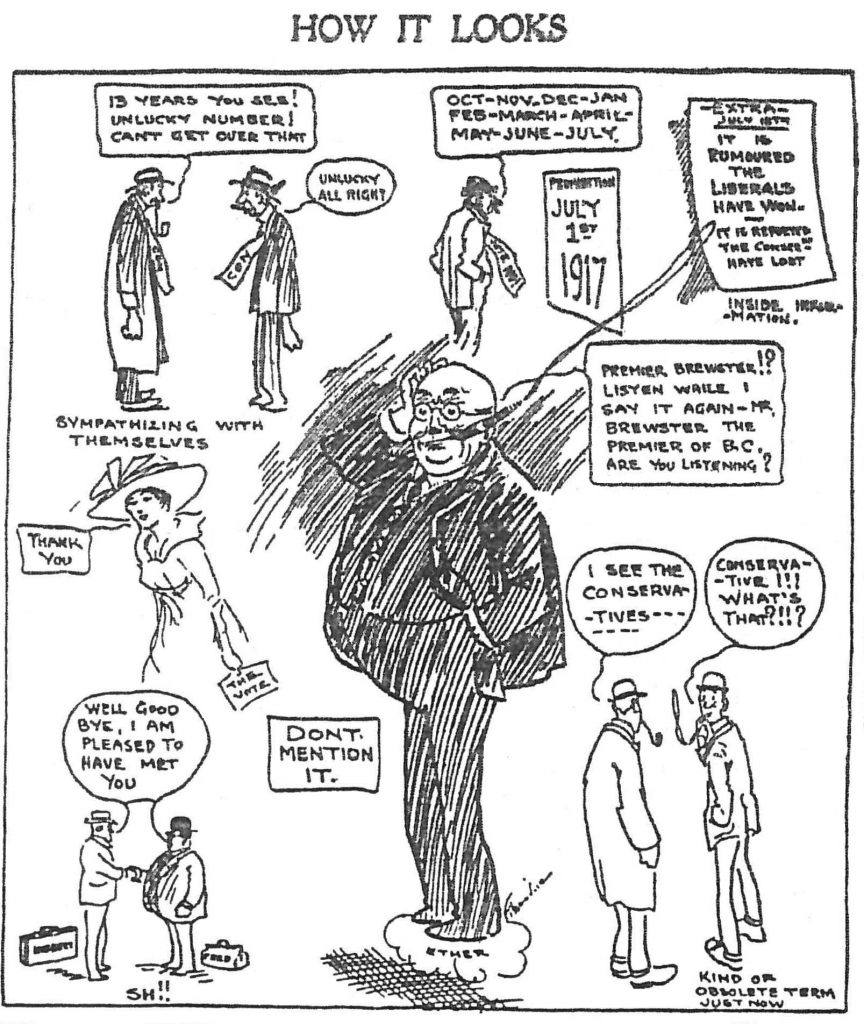
Figure 2: How it Looks
Two days later appeared Fitzmaurice’s post-election cartoon “How It Looks” (Figure 2). The new Liberal Premier, Brewster, dominates the centre of the image and a figure representing women thanks male voters for delivering a two-to-one majority Yes vote on the suffrage referendum. In contrast, Fitz’s anxiety over the successful passage of the prohibition referendum is clear: a male figure counts down the months left before the fatal day when the bars close. As we shall see, Fitzmaurice accepted the principle of women’s suffrage graciously, but what he saw as the practical reality of sending elected women representatives to the legislature would provide the cartoonist a vehicle for a series of misogynist cartoons and for us provide a window into male attitudes to women in the period. As for prohibition, Fitz was never a supporter and his cartoons on the state’s troubled efforts to restrict alcohol consumption after the referendum left little doubt on where he stood.
WHEN WOMEN RULE
Since the 1960s, historians have written extensively about the lives of women and in particular the middle-class gender expectations in the 19th century that sought to restrict women to domestic roles, such as childcare and household labour. Economic life and participation in government expanded for men in the 19th century, but women were not asked to join them. This growing difference, really subordination, was reflected in the fact that women were denied the vote or the opportunity to run for political office.
Fitzmaurice’s images of women reflected commonly-held, middle-class male understandings of women’s nature. In Fitz’s cartoon universe there was a narrow stable of female types, and all of these adhered to well-worn gendered stereotypes. He used, for instance, allegorical figures in female form to represent nations or collectives, such as Madame Canada or Britannia, or certain virtues or principles, such as Justice or Democracy. These kinds of allegorical symbols in cartoons were used more often by cartoonists in the decades before the war, and their use declined with the growth and popularity of sequential cartoons and comics. They simply went out of style. More common in Fitzmaurice’s wartime images, especially his home front cartoons, were unhistorical, generic female stereotypes – for instance, the female counterpart to his Mr Everyman. Fitz never caricatured actual women in public life, as he did with so many male figures, and there were many well-known women activists to choose from by the middle of the war. To do so might have given these women greater legitimate weight. Instead, Fitzmaurice’s generic women, even his suffragettes, were faceless and bound by a set of gendered and severely limiting behaviours from which they could never escape.
A pre-war Fitzmaurice cartoon from 1909 demonstrates his attitude towards women and political reform in particular. In “Hunger Strikes” (Figure 3) the female activist joins the suffragist hunger strike to lose weight, not for higher political principles. We are presented with a mocking parody of the steps of political consciousness – from dissatisfaction to inspiration, determination, martyrization, and realization. Fitzmaurice asks, “Can it be possible that fashion is responsible for them?”
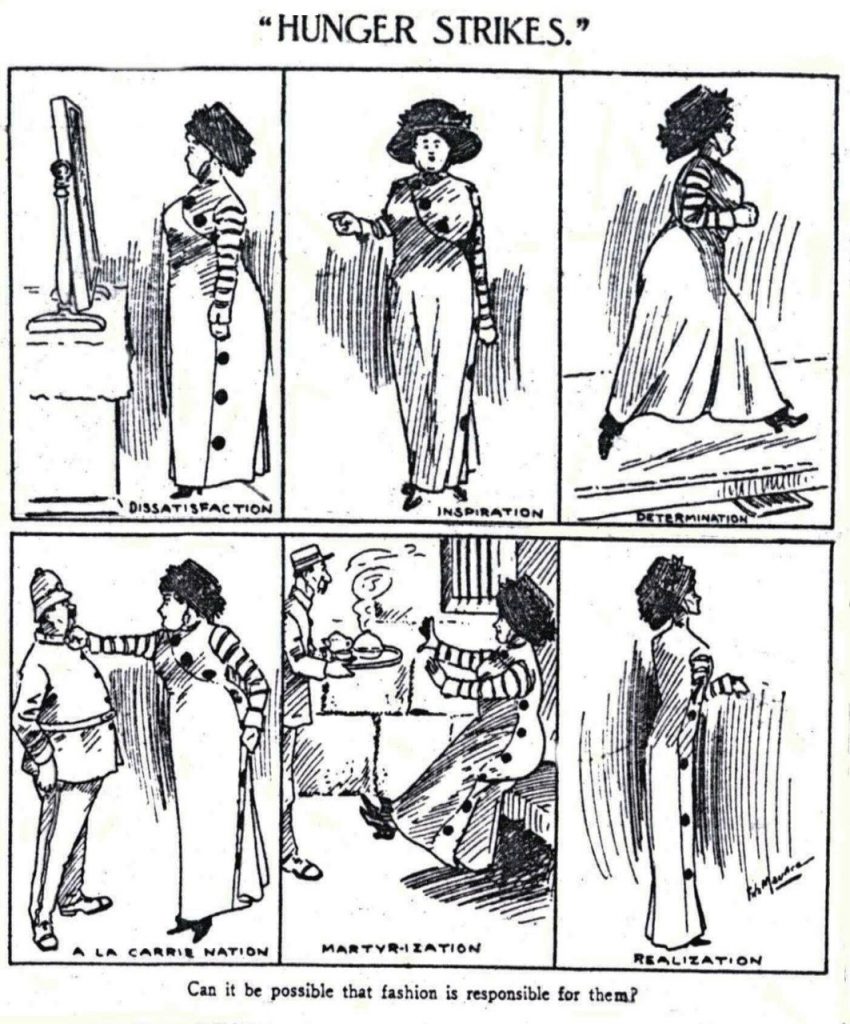
Figure 3: Hunger Strikes
In these ridiculing images women are hopelessly vain, obsessed with their physical appearance, prisoners of an emergent consumerism, and unable to think beyond their own personal and domestic needs. In fact, these were among the core arguments traditionally raised by men in opposition to women’s suffrage and women’s participation in public life. And two decades of first wave feminist activism, the elevated participation of women in the war effort, and the successful passage of the provincial suffrage referendum apparently did nothing to change that. If Fitzmaurice is typical, men continued to believe women were inherently unsuited to political life.
Following the successful referendum, the concrete legislative steps to full female enfranchisement still required constant pressure from women’s groups. Delays in counting ballots from soldiers overseas meant the promised date for enfranchisement of January 1, 1917 was allowed to lapse. In response, a large delegation of concerned activists arrived in Victoria to demand Brewster and the new Liberal government introduce a separate Bill to amend the Provincial Election Act, and this was completed on April 5, 1917.
The real test of provincial women’s enfranchisement came with a by-election in January 1918 to fill the seat made vacant by the death of key Liberal cabinet minister Ralph Smith in February 1917. The Liberals chose Ralph Smith’s activist wife, Mary Ellen (Spear) Smith, to contest the by-election. Ralph and Mary Ellen Smith had proven to be a powerful reform team in both federal and provincial politics since the 1890s. Historian Veronica Strong-Boag writes: “Their political partnership, much like that of many feminists of their generation such as the Aberdeens and the Pankhursts, was crucial to mutual success. Not untypically, she was known to write some of her husband’s speeches.” Over the course of several decades, Mary Ellen Smith built up an impressive independent record in the women’s movement, in organizations such as Nanaimo’s Hospital Auxiliary and Laurier Liberal Ladies League and Vancouver’s Local Council of Women, Women’s Canadian Club, City Creche, the Imperial Order of the Daughters of the Empire, and the Political Equity League. She also championed the University of British Columbia, old age pensions, and health insurance. Mary Ellen Spear was far more than Ralph Smith’s wife; she was an experienced force in the organized public life of the province and a good choice to fill her husband’s seat.
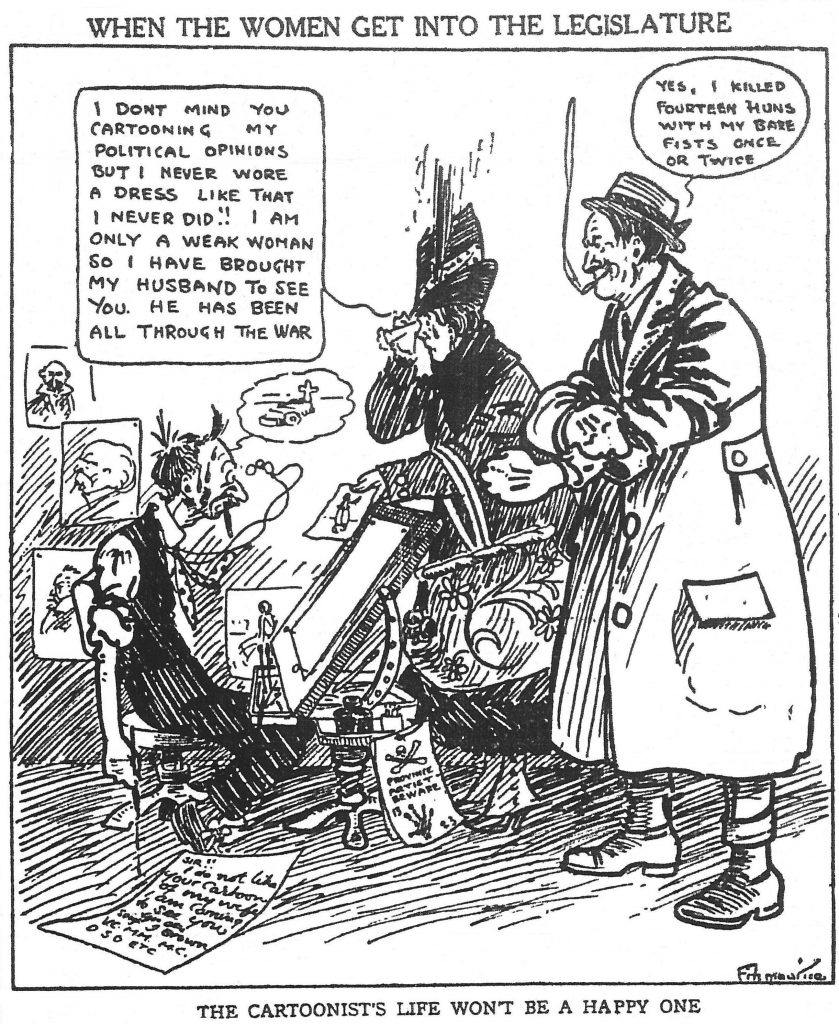
Figure 4: When Women Get into the Legislature
Fitzmaurice ignored both Smith and her achievements and instead introduced a series of cartoons during the by-election that mocked the “feminine invasion of the legislature.” The first of these, “When the Women get into the Legislature” (Figure 4), from 4 January 1918 is a memorable, single-frame cartoon that candidly features a caricature of Fitzmaurice himself struggling with the prospect of producing visual political criticism of an elected female politician. “I don’t mind you cartooning my political opinions,” sobs the offended MLA, “but I never wore a dress like that I never did!!” Apparently unable and unwilling to defend herself against the cartoonist, she has brought her burly war veteran husband to settle the score. “Yes,” he says as he rolls up his sleeves, “I killed fourteen Huns with my bare fists once or twice.”
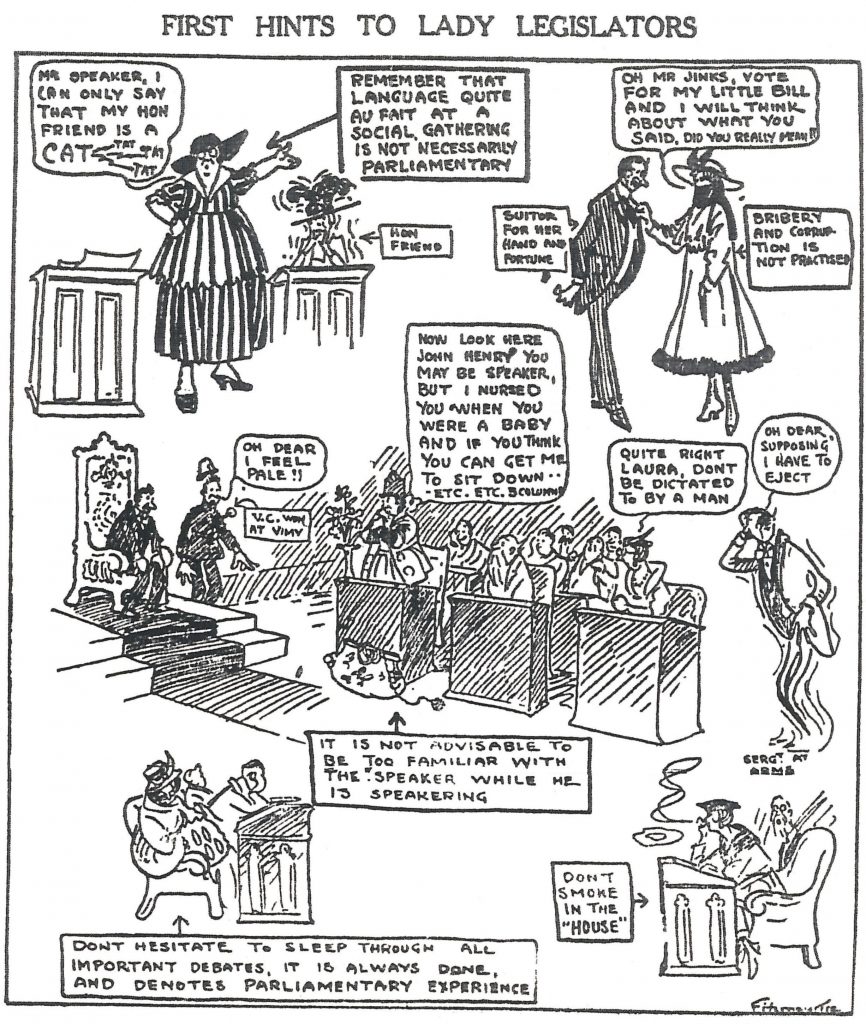
Figure 5: First Hints to Lady Legislators
The following day Fitzmaurice lectured prospective women MLAs in “First Hints to Lady Legislators (Figure 5). Demeaning female stereotypes abound in this cartoon. Beneath what are really behaviours that might normally be reserved for domestic or family life is a belief that women cannot follow rules, learn new situations, or grow as human beings. They are prisoners of their essentials natures. Mind you, men do not come off much better in this cartoon.
As with all of Fitz’s domestic males, these political men are intimidated by the women in their midst. Even the legislative guard, a veteran who recently was awarded the Victoria Cross for bravery at Vimy, is about to faint in the presence of an aggressive verbal attack on the Speaker. In truth, Fitzmaurice had no idea what to expect when women joined the ranks of elected politicians. In “When Women Rule” (Figure 6) he muses that women will simply slide into pre-existing male political types. While visually Fitz dips into the well of female impersonation, a tried and true comic device used by cartoonists in this period, the concept behind the cartoon more accurately suggests male impersonation, quite a different humorous juxtaposition that would have well-known women dressed up as particular male political types.
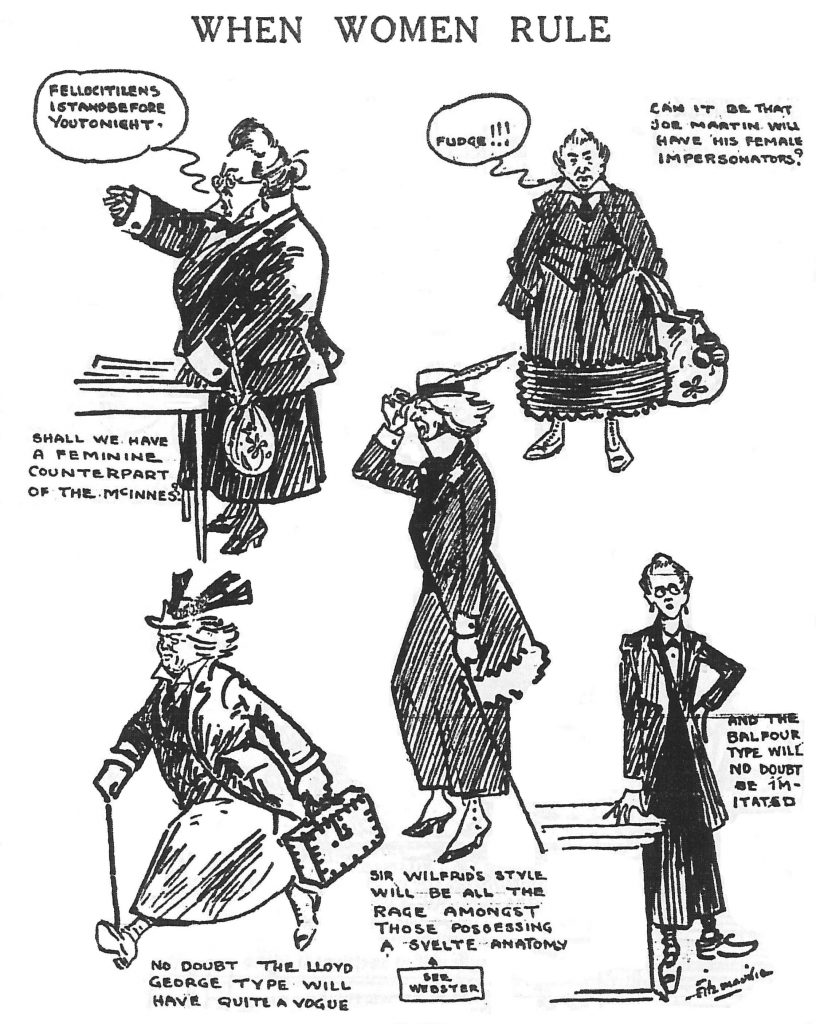
Figure 6: When Women Rule
The laws of caricature, however, exist to support the familiar, and here we see the lazy cartoonist use the easily recognizable British politicians Lloyd-George, Lord Balfour, Canadian ex-Prime Minister Wilfrid Laurier, and Fitz’s personal provincial favourites W.W.B. McInnes and perennial political contestant Joe Martin.
In the last couple days before the by-election, Fitzmaurice slipped the actual names of the two main candidates into two cartoons. Both of these images are interesting because of what they say about gender and the distinctions between home and public life. The first, “Keeping the Home out of Politics” (Figure 7), offers us a glimpse into a comfortable middle-class Vancouver home as matriarch and patriarch prepare to deliver rather formal speeches in defense of their chosen candidates, Mrs. Smith (Independent-Liberal) and Walter Drinnan (Conservative). As might be predicted, daughters and sons line up in gendered fashion to support either their mother or father. The domestic servants shown as shadowy figures at the back of the room attend but do not participate.
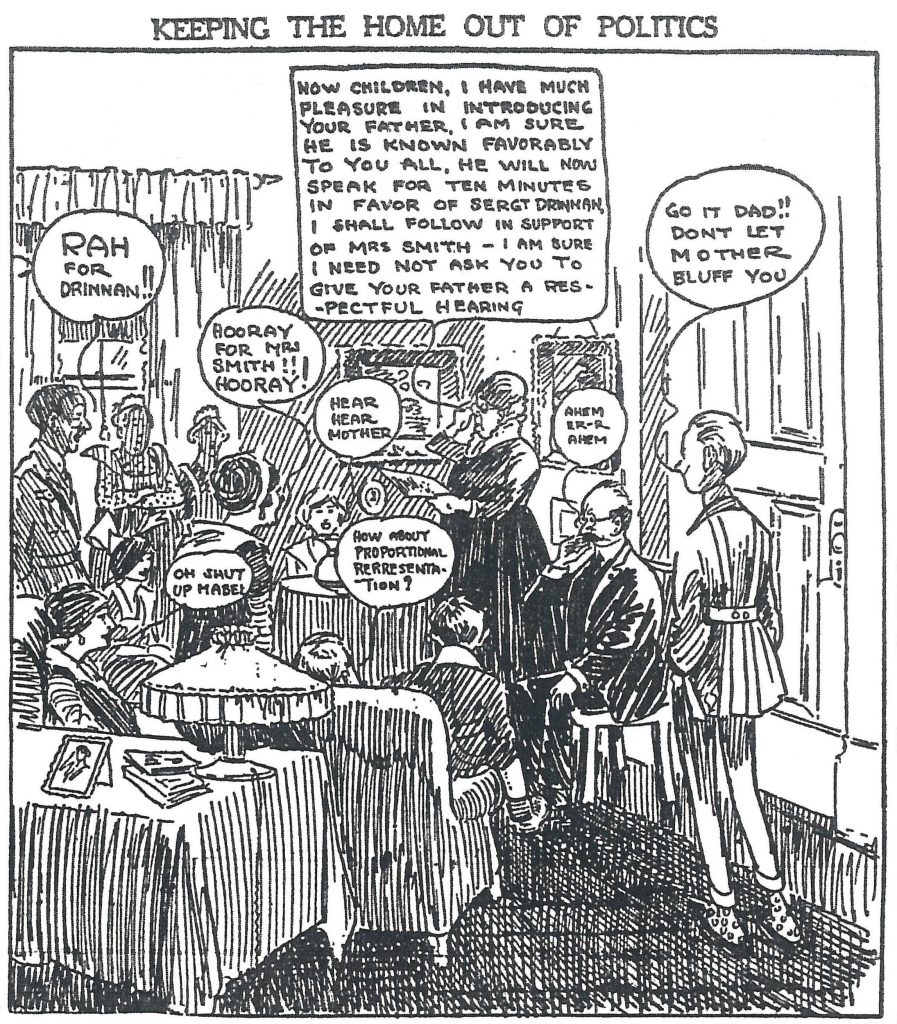
Figure 7: Keeping the Home out of Politics
Fitz is playing with one of the potent pre-war fears raised against women’s enfranchisement: that home life would suffer by drawing women and the domestic sphere into public affairs. The war, of course, shattered some of these concerns at the same time as it built the moral rationale for women’s political rights. This cartoon reflects the novelty, excitement, and playfulness that probably did occur in many middle-class households during the by-election. It also anticipated later comic movie plots in the 1930s and 1940s built around political divisions within families and between the sexes. We see these family comedies now through a nostalgic lens on to a charming and gentler time. But this was all brand new in January 1918, and Fitzmaurice was memorializing on the spot.
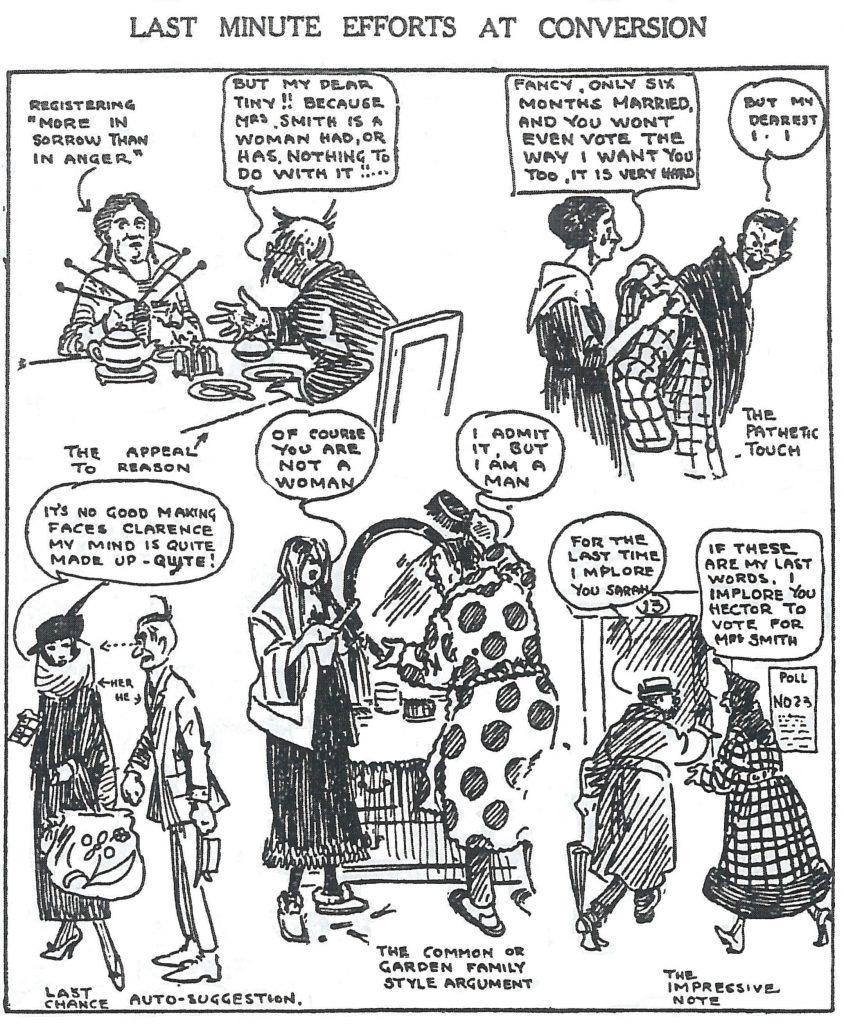
Figure 8: Last Minute Efforts at Conversion
In “Last Minute Efforts at Conversion” (Figure 8), from the day of the polls on January 24 1918, Fitzmaurice continues the assumption that the vote would be split down gender lines.
Here we see couples attempting, with no success, to alter each other’s mind at the eleventh hour. “Of course,” says the woman preparing for the day, “you are not a woman.” “I admit it,” the husband responds, “but I am a man.” Underpinning these hopeless appeals are ingrained stereotypes that permanently separated men with rational minds from women with emotional natures. Says the tearful wife helping her husband with his coat, “Fancy, only six months married, and you won’t even vote the way I want you too. It is very hard.” In the end, Smith handily defeated her main opponent Drinnan 10,213 votes to 6701, suggesting that more than gender explained the breakdown of the vote. The local press was surprised, not that she won the election, but that she carried the support of so many male voters. One disappointed official with the Drinnan campaign complained that “hundreds of men voted for Mrs. Smith because of the novelty of a woman candidate.” In retrospect, Smith’s victory was a great achievement given the hurdles in front of her. She was the only Liberal-leaning candidate to win in the four by-elections run that day – by-elections traditionally are very difficult for government parties to win – and her opponent, Sargent Walter Drinnan, was a popular returning soldier and a key figure in the influential Great War Veterans Association (GWVA). Disappointed editorial writers at the Province framed the results in the moral language of wartime sacrifice, suggesting that voters had turned their backs on their men in uniform. For his part, nothing in Fitzmaurice’s work had anticipated the election’s apparent softening of gender divisions.
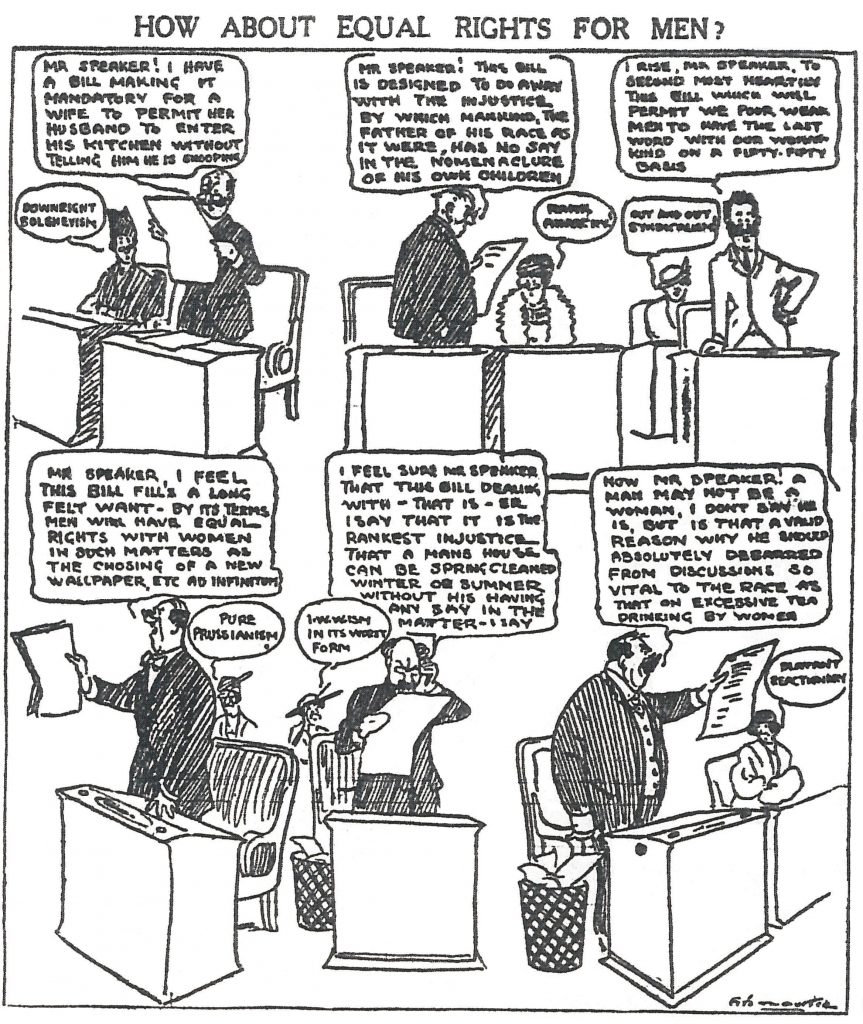
Figure 9: How About Equal Rights for Men
Fitzmaurice produced one final, and predictable, cartoon on the enfranchisement of women a month after Mary Ellen Smith’s victory titled “How About Equal Rights for Men?” (Figure 9). Fitz’s men might have lost the battle over women’s political rights, but they were still determined to win the war of the sexes. And the theater of conflict now turned to the home front. In turn, each male member of the elected house stands to support legislation undermining women’s power in the domestic sphere. “Mr. Speaker,” declares the first MLA, “I have a Bill making it mandatory for a wife to permit her husband to enter his kitchen without telling him he is snooping.” Another male member seconds a Bill that would allow men to have the last word in arguments with “our woman kind on a fifty-fifty basis.” Some comments in the image are barely legible today, but the real humour is in the female members’ responses to each Bill. “Downright Bolshevism” responds the first woman to legislation allowing men to enter the kitchen. “Out and Out Syndicalism” mutters the elected female member allowing men an equal share of the last word. “Pure Prussianism” another calls out against a bill that would give men equal rights in choosing new wallpaper. It is ironic that the female member in the final vignette responds with “Blatant Reactionary,” given the reactionary nature of the cartoon itself.
Indeed, all of Fitzmaurice’s cartoons on the drive for women’s political equality are reactionary images from a male perspective and built with the then-safe gender stereotypes of women’s true nature that belied their right to share public power with men.
WHEN THEY TURN THE BARS INTO TEAROOMS
Fitzmaurice probably had typical middle-class male attitudes towards women’s enfranchisement in 1918 – at once welcoming it as a deserved reward for women’s wartime contributions but also ridiculing the idea of women in elected positions. But there was no confusion about Fitz’s attitude towards prohibition – he was against it, and consistently so.
The organized movement against alcohol consumption had a longer history than the movement for women’s suffrage, reaching back into the early 19th century in the United States and even earlier in Great Britain. In England, concern for the social problems created by strong intoxicants grew in the late 17th century with the massive expansion in production of so-called “ardent spirits.” By the 1790s England was producing 4 million gallons of gin a year and that number would multiply in the 18th century as prices fell with an economy of scale to meet the needs of a growing and thirsty population. Reformer in this early period made a distinction between the evils of distilled alcohol, like gin, whiskey and rum, and the more acceptable lighter beers and wines which had a longer history rooted in medicinal and liturgical use.
As the eighteenth century drew to a close, two approaches to controlling alcohol consumption were evident. “Temperance” advocates, like most 19th century social reformers, emphasized personal responsibility and voluntary action in affecting social change. They argued that state enforcement was a less effective and enduring tool than individual commitment, and because most temperance reformers were attached to churches, they were worried about the intrusions of government into social life and its consequences on religion and personal initiative. Government in the 19th century was small and its powers more restricted to the economy, military and diplomatic affairs, and formal law. Temperance advocates was the role of organized, voluntary citizens as central to beating the scourge of ‘demon rum,’ not the state. While the volunteer spirit of temperance held sway through most of the 19th century, the lack of concrete success in lessening the use of alcohol led reformers to search for more powerful tools of enforcement.
The other approach to the control of alcohol consumption was prohibition through the power of government laws and regulations. While voluntary temperance dominated the movement early on, there were always some voices who called for state enforcement. In his study of prohibition in British Columbia, Douglas Hamilton tells the story of the influential American prohibitionist Neal Dow, who roughed out many of the reasons and regulations to support enforcement of liquor laws while mayor of Portland Maine in the 1880s. Dow recognized the limits of volunteerism and instead “turned to the police, courts and jails as his allies in rooting out the drinking scourge. He pushed hard for strict laws banning the manufacture and sale of all alcohol.” As is usually the case with intoxicants, enforcement was the challenge, and soon jurisdiction after jurisdiction that had followed the Maine model soon abandoned their prohibition laws as impractical – the creativity of both the sellers and consumers of alcohol was, quite simply, irrepressible. The limited enthusiasm for state intervention waned after mid-century, but temperance advocates continued to organize and draw recruits with the emergence of the urban social reform movements in response to rapid industrial change in the 1880s and 1890s.
It is difficult to empathize today with the prohibitionists of the late 19th and early 20th centuries. We live in a European-based society that has come to fetishize alcohol consumption, particularly with the proliferation and cultural penetration of the high-end wine and beer industries as bourgeois lifestyle necessities. Who has not been impressed with the capitalization of the Okanagan wine industry and its stylistic mimicry of fashionable vineyards in California, France or Spain? Drinking has become attractive. As well, we have come to define consumptive choice as a basic human right; yet in doing so we often fail to see this liberal ideology of consumption as part of a monumental shift in the capitalist system away from an emphasis on production and producers towards consumption and consumers. Within present day consumer capitalism the right to purchase is sacrosanct. In this light, the movement to legalize marijuana is hardly counter-culture; it is mainstream-culture. Marijuana activist Marc Emery might be called the “Prince of Pot,” but he is more accurately an agent of modern consumer capitalism.
Against this modern liberality, the stiff, moralizing of prohibitionists a century ago appear comical and misdirected. However, by any standard alcohol consumption in the decades before the First World War was impressive and disconcerting. In Canada, British Columbia led the way. According to the 1896 Royal Commission on the Liquor Traffic, British Columbians consumed twice the per capita volume of all spirits compared to all other provinces. Part of this was due to the male character of the resource industries. But as Douglas Hamilton points out, drink was a constant in working-class family life in more settled communities as well:
The day would start with a healthy dollop of whisky for every member of the family, often including children. This was followed by an 11 a.m. grog break. Wine and beer accompanied a hearty lunch, with further refreshment for a 4 p.m. break. Port and wine were served with supper, and then the family retired to a nearby tavern to hear the latest news and gossip.
And there was no shortage of drinking establishments to choose from. New Westminster boasted one saloon for every thirteen residents in the 1880s. In smaller resource towns such as Nanaimo the percentage was much higher. For decades social historians have sketched out the multiple roles these drinking spots served, especially for working class men. The tavern was open most of the day and night, offered cheap sometimes free food, functioned as an informal employment bureau, contained various forms of appropriate and inappropriate entertainment – Montreal’s “Joe Beef Tavern” famously kept live bears and hosted dog fighting for gambling purposes in the 1870s – and was generally a centre for working-class needs.
However, bar life was not restricted to the working class. In Victoria and Vancouver, specialty bars existed to cater to more refined tastes and even specific professions and interests. The sports bar, for instance, was born in the first decade of the 20th century. Vancouver sportsmen made up mostly of young men from the city’s financial and commercial sector flocked to the Beaver Billiards Bar in the summer to mix with local professional and amateur baseball players. Like sport itself, bar life was largely male reserve.
It was against this male edifice of drink that the temperance and later prohibition movement railed for generations. Success had to wait, however, for the special conditions of self-sacrifice and repression of personal pleasure during the war. After the passage of the 1916 prohibition referendum, the British Columbia government moved to implement prohibition on October 1 1917. The regulations governing prohibition were proposed earlier in May 1916, and the Prohibition Act was long, complicated, and designed to satisfy key Liberal constituencies. Making and consuming liquor was still legal, but only in what was termed a “dwelling house.” A “dwelling house” was defined to exclude bars, taverns, hotels, restaurants, businesses, offices, or parks. Of course, ambiguities existed, and these gray areas were seized upon by inventive drinkers while prohibition was in force. Prohibited liquor was defined as any drink over 1.25 per cent alcohol (2.5 proof), which allowed for so-called “near-beer,” brewed to the allowable limit, to be sold in bars, hotels, and restaurants. Many bars continued to operate quite successfully on the basis of near-beer sales, demonstrating the tenacity of the marketplace and suggesting that British Columbians simply adjusted their consumption habits under prohibition.
In addition to selling, the bartering or gifting of alcohol was illegal, and the punishments were severe: six to twelve months in prison for the first offense; twelve to twenty-one months for the second. Consuming liquor illegally received a lighter penalty – a 50 to 100 dollar fine – but those without the ready cash to pay the fine could spend a month or two in jail. The Act gave police extensive powers to enforce prohibition laws, including the right to enter any “house, business, or vehicle” without a warrant. Finally, the Act included two important exceptions. The first allowed people to import liquor from outside British Columbia for allowable consumption within their own homes. This allowance was made necessary by the constitutional limits provincial governments could impose on inter-provincial trade, but some evidence suggests the Conservative government which drafted the Act would have allowed direct importation to dwelling houses in any case. The second exception made the purchase of alcohol for “medicinal use” legal. Medicinal alcohol required a doctor’s prescription and could be bought in drug stores or through a government office. Many of the province’s physicians grew rich selling referrals to British Columbians at two to four dollars a pop. In 1919, more than 300,000 prescriptions were filled, in a province with a total population of just over 450,000.
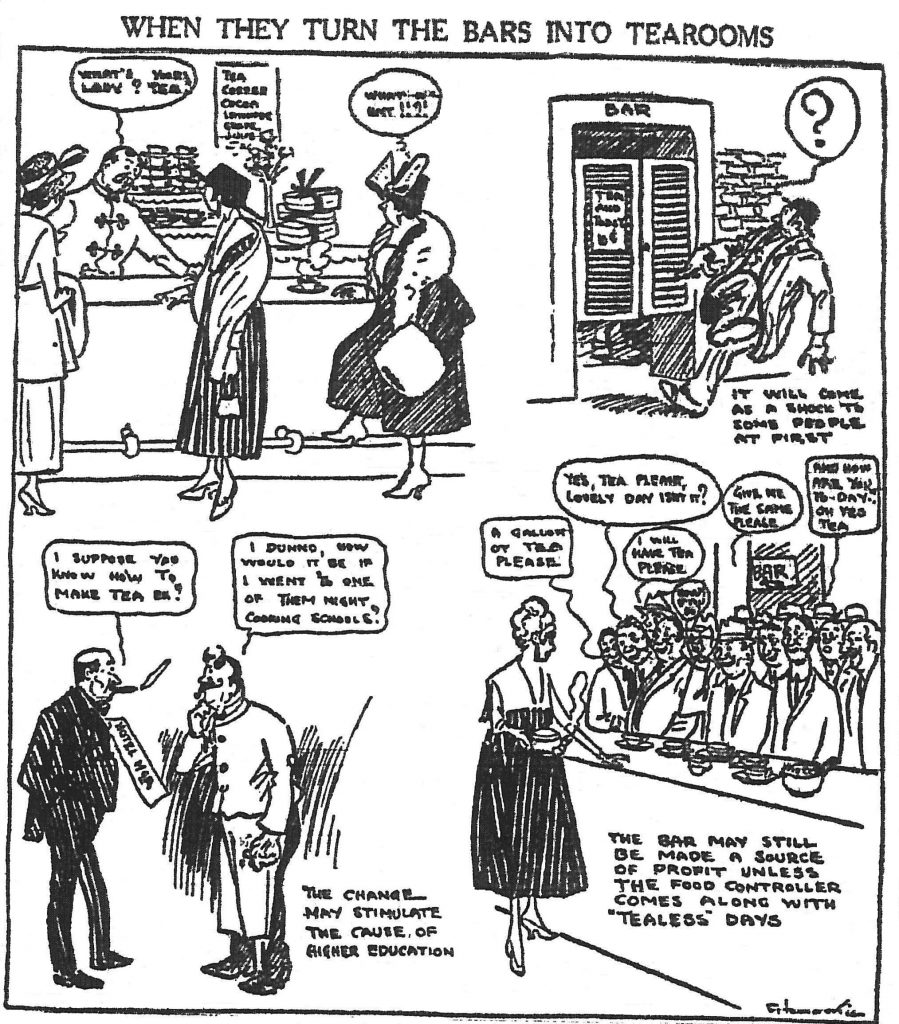
Figure 10: When They Turn the Bars into Tearooms
Fitzmaurice was not a fan of prohibition and many of his cartoons ridiculed the attempts by government to control liquor consumption, which he steadfastly defined as a male right. Two weeks before the Prohibition Act became law, Fitz produced “When They Turn the Bars into Tearooms” (Figure 10). Each vignette builds its humour through various invasions of the bar. “What’s yours lady? Tea?” asks the newly refashioned tearoom bartender of his well-dressed female customers. The attack by middle-class women on the sanctity of male space is a central theme in most of these images.
To Fitzmaurice the original bar was an eternal, unchanging, and uncritical site for male interaction, all of it simple in character and concrete in substance. The bar was not a nuanced space. You did not “think” in a bar. It was a protected place to play out predictable and practiced behaviours amongst other men who also knew the rules. “I suppose you know how to make tea eh?” asks the cigar-smoking hotel manager to his bartender. “I dunno,” replies the barkeep, “how would it be if I went to one of them night cooking schools?” Prohibition would undermine the comfort of low expectations: “The change may stimulate the cause of education,” suggests Fitzmaurice.
Fitzmaurice played upon the medicinal allowance for alcohol in his late September 1917 offering “There Seems to be an Awful Lot of Sickness About” (Figure 11). Each character in the frame rationalizes his or her medical reasons for booze directly to the reader. And it is in the rationales where humour lies. “I hate the stuff but unfortunately it is the only thing that will cure my ailment,” says one man carrying a jug. Another weighed down with bottles and a jug claims, “Of course I don’t drink, but my kind of constitution needs a stimulant.” In a lovely turn of Fitzmaurian phrase the last man admits, “I find that alcohol is the only thing that will cure that cold I always have.”
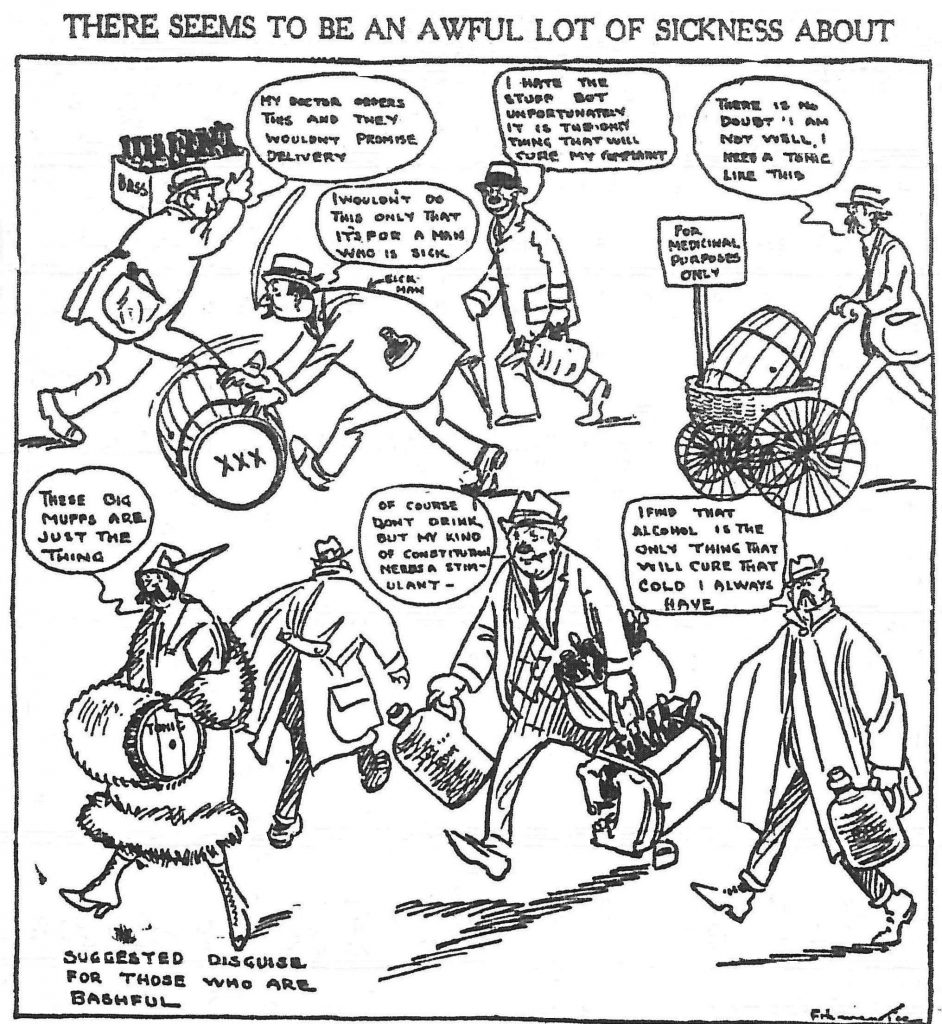
Figure 12: There Seems to be an Awful Lot of Sickness About
The overlap of personal determination and public deception, of truth and falsehood, so gently done, allows a timelessness to this humour. In Fitz’s universe people did what was necessary to satisfy their needs, but always with an eye on public perception.
In retrospect, “There Seems to be an Awful Lot of Sickness About” is an interesting premonition on the Spanish Influenza pandemic that would soon hit all parts of the globe, beginning in January 1918, and which arrived in Vancouver by the fall of that year. The Spanish Flu is considered “the greatest medical holocaust in history” and has been referred to recently as “the Mother of all Pandemics” by the American Centers for Disease Control and Prevention. The pandemic killed over fifty million people world-wide and around 50,000 in Canada. At least ten times those numbers fell seriously ill from what we now know was the H1N1 virus, which uniquely attacked the young and healthy because of their strong immune system over-reactions. We are just beginning to understand the effects of the pandemic in specific Canadian communities, but a recent study by Sarah Buchanan has estimated that over 1150 Vancouverites died of the Flu over an eighteen month period from its arrival to the city in October 1918 until its dissipation in March 1919. The mortality rate in Vancouver was 8.3 per cent, higher than the national average, and the Flu was responsible for almost 50 per cent of the deaths over that period. The context of wartime censorship and controls on the media, however, meant that the extent of the pandemic was not made clear to the public. As a consequence, Fitzmaurice never once produced a cartoon on the Spanish Flu – not even an image to support the emergency goals of public health. The closest we have are his cartoons that parrot the popular wisdom that alcohol could help prevent sickness, such as the 1919 image “Prevention is Better Than Cure” (Figure 12). Other than the veiled reference in the centre vignette to “a case of flu in South Borneo,” you would never know the devastation the Spanish Flu had on the local community.
Prohibition in British Columbia soon became more tightly controlled when the federal government, buoyed by wartime consensus, implemented national prohibition in April 1918. Loopholes that had plagued the system, such as interprovincial trade and importation from outside Canada, were eliminated, and the production of alcohol over 2.5 per cent was banned across the country. Provincial regulations continued to be in force, and the British Columbia government appointed a Prohibition Commissioner, W.C. Findlay, to see that the regulations were strictly followed. Findlay was a prominent leader in the influential Peoples’ Prohibition Association (PPA) and the obvious choice for Commissioner. But to everyone’s surprise in December 1918, Findlay was charged with illegally importing a large amount of high-end rye whiskey – seven hundred cases with a potential street value or 84,000 dollars – with the intention of selling it to enrich himself. Prohibition was already straining from cracks in the system, a cumbersome bureaucracy, and notoriously weak enforcement. But news that the man in charge, a respected crusader in the movement, was a flagrant bootlegger was a blow against public support for prohibition.
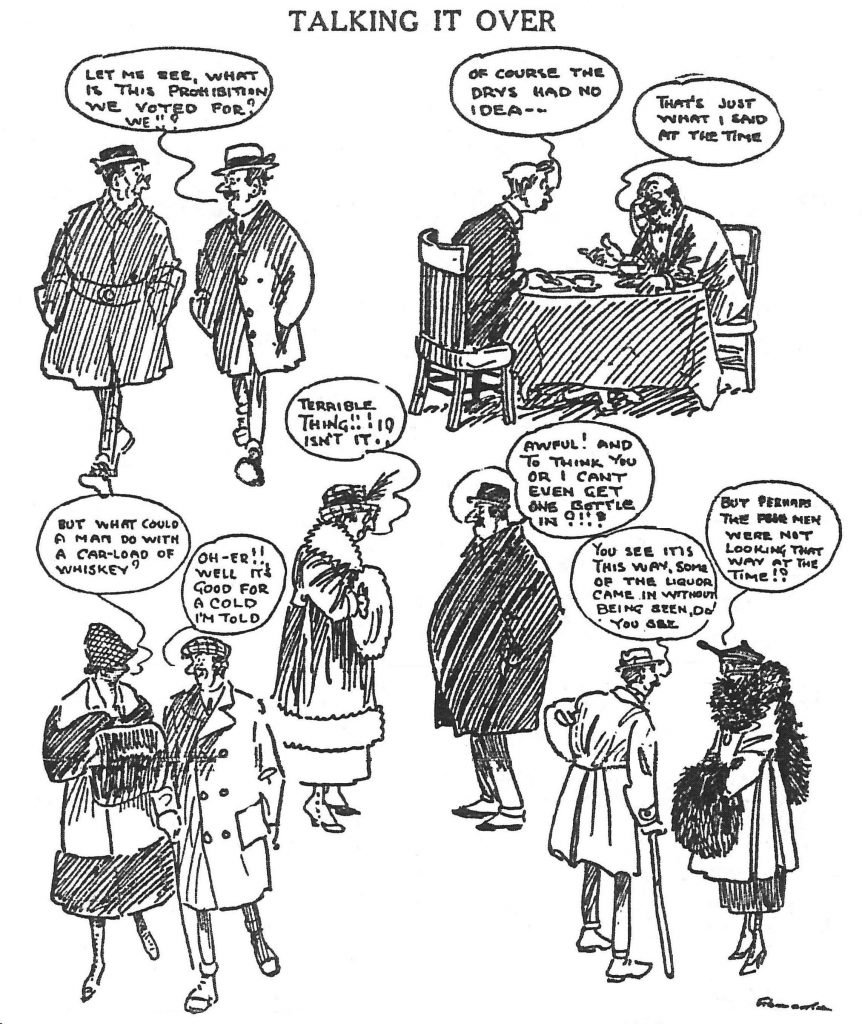
Figure 13: Talking it Over
Fitzmaurice produced “Talking It Over” (Figure 13) on the day of Findlay’s arrest. Middle-class Vancouverites are pictured in separate conversations trying to grapple with the news of Findlay’s actions. Significantly, none of the characters appear to be supporters of prohibition. “Let me see,” caustically asks the first man, “What is this Prohibition we voted for? We!!?” Over lunch two men use the Findlay revelation to confirm their own suspicions that Prohibition was destined to fail: “Of course the Drys had no idea –“ says one; “That’s just what I said at the time,” confirms the other. The centre vignette reflects the increasing frustration anti-prohibitionists felt with the controls brought in by national prohibition earlier that year. “Terrible thing!! Isn’t it!?” declares the woman in surprise. “Awful!” the man responds, “and to think you or I can’t even get one bottle in!!!!” Findlay proved to be uncooperative with police and equally silent under questioning by a hastily called provincial commission charged with examining illegal liquor traffic. Historians have since suggested Findlay’s public silence, his guilty plea, and the large amounts of liquor involved point to the existence of a well-developed underground illegal distribution network and the involvement of men at the highest levels of law enforcement, business, and politics. In short, homegrown corruption. In the end, Findlay served two years in prison, but more importantly, prohibition was damaged even further by the Findlay fiasco.
The end of prohibition in British Columbia came in fits and starts. National prohibition had always been framed as a temporary wartime measure, in part to satisfy Quebec, and as such federal prohibition lapsed at the end of 1919. Without controls on interprovincial transport or the manufacture of liquor, British Columbia’s prohibition was undermined even more. Historian Robert Campbell writes that by 1920 many British Columbians were thoroughly disillusioned with prohibition. The reform rhetoric of the war years had proved hollow; neither the war nor prohibition created a new era. Instead, residents endured a post-war recession. Most returned soldiers were not happy about job prospects or the lack of beer. Ordinary citizens complained about prohibition because it made criminals out of otherwise respectable people who wanted to drink, and because defiance of prohibition encouraged disrespect for the law in general. To many, prohibition not only violated British notions of justice and liberty in theory, but had proved itself a dismal failure in practice.
Soon the provincial Liberal government also grew tired of maintaining an ineffective, costly system of enforcement. In addition, the potential government revenue from a state-run liquor retail operation made increasing sense to help pay down a large post-war provincial government debt. ‘Moderation’ became the watchword of the anti-prohibition forces in the province. A Moderation League was founded to push the vision of a new measured approach to “reasonable” alcohol consumption mediated by government regulations. The forces of prohibition, however, were not dead; the PPA was still a powerful body and the arguments against alcohol still carried weight in many quarters. Looking for a political solution on an issue that divided the province, and the Liberal party, the government announced a plebiscite would be held on the future of prohibition on October 20, 1920. The debate leading up to the vote was vigorous, but the clever strategic positioning of the moderationists won the day with a two-thirds majority of the vote.
The repeal of the 1916 Prohibition Act and the passage of the new Liquor Act came in the spring of 1921. The new Act was promoted by the Liberal government as an act of reasonable moderation: there would be no return to the unregulated bar and saloon scene that existed before the war; government liquor stores would be established where alcohol would be sold in “sealed packages;” and enforcement against bootleggers would be stepped up and more vigorously policed. A portion of the profits generated by the lucrative government liquor stores would be distributed to local communities to ensure compliance.
Fitzmaurice and his newspaper were avid supporters of the new liquor reality, and the cartoonist marked the opening of the first government liquor stores on June 15 1921 with the cartoon “The Best of Friends Must Part” (Figure 14). The image begs little explanation: Mr. Prohibition bids a tearful farewell to Mr. BC, who respectfully shakes hands goodbye, but clearly hopes he has seen the last of his abstaining friend. The visual presentation of the two characters is crucial to the cartoon’s intent. Mr. Prohibition is dressed as a relic of the 19th century with hints of a travelling preacher from generations past. In contrast, Mr. BC is the epitome of modernity, a prosperous dandy ready to meet the jazz age head-on. In Fitz’s view prohibition was a fossil from the past – British Columbia’s future lay in responsible access to drink.
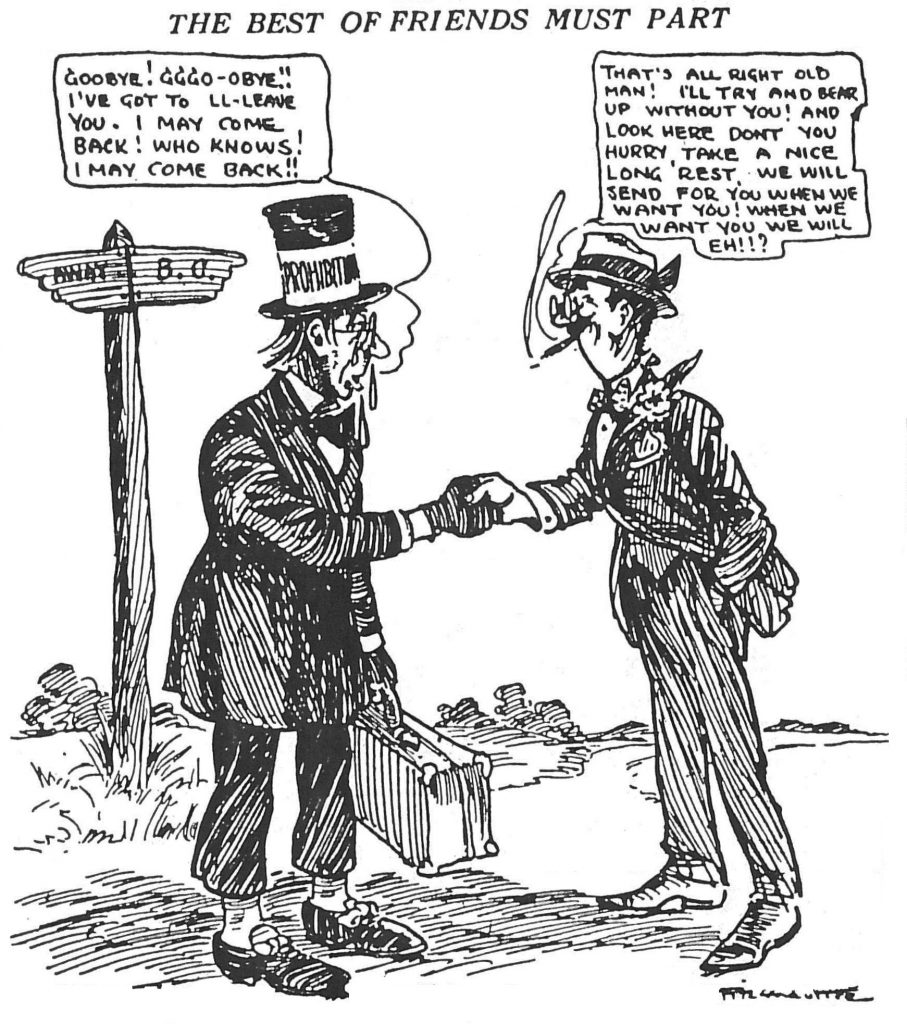
Figure 14: The Best of Friends Must Part
Fitzmaurice’s wartime treatment of women’s political rights and the province’s experience with prohibition represent only a moment in what have been long and complex historical issues. A century later we are still seeking greater equality for women and we continue to search for the right balance between access to intoxicants and their troublesome effects. In his time, Fitzmaurice saw the two issues as linked, and most historians have agreed. Suffragists were invariably supporters of prohibition. Most middle-class reform women saw women’s enfranchisement and prohibition as necessary steps to improving social conditions. Fitzmaurice, however, was not a fan of either, and his attitude towards women in power and what he viewed as an invasion of the male space in the bar was likely typical of many men in that period. It is interesting that Fitz felt free to express his criticisms of prohibition openly, but was much more indirect in his equally dismissive position on women in politics. It is that lack of authentic men’s support for women that continues to slow real advancements for women today.